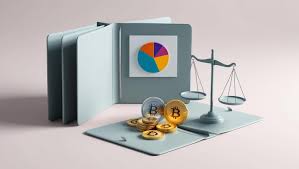Building a digital asset portfolio is a strategic and rewarding endeavor, but it can feel overwhelming for beginners. Whether you’re new to investing or exploring the world of cryptocurrency and blockchain technology, this guide is designed to give you a solid foundation in building your digital asset portfolio. By understanding key concepts and developing a thoughtful strategy, you can start making informed decisions that may lead to long-term success in the digital economy.
What Is a Digital Asset Portfolio?
A digital asset portfolio refers to a collection of investments in digital assets, which may include cryptocurrencies, tokenized assets, and other blockchain-based assets. As the digital world continues to grow, these assets have gained traction as alternative investment opportunities. Some of the most well-known digital assets include Bitcoin, Ethereum, and other altcoins, but there are many other options available.
A well-rounded digital asset portfolio aims to diversify investments across multiple assets to reduce risk and maximize potential returns. Like traditional investment portfolios, a digital asset portfolio is designed to reflect an investor’s goals, risk tolerance, and investment horizon. Understanding how to balance risk and reward is critical to building a strong portfolio that can withstand market fluctuations.
Why Should You Build a Digital Asset Portfolio?
Investing in digital assets offers several unique advantages. For starters, these assets can be highly liquid, meaning they can be easily bought, sold, or exchanged for other assets or fiat currency. Moreover, digital assets operate outside the traditional banking system, providing an alternative investment avenue for those seeking financial independence or looking to hedge against traditional market volatility.
Blockchain technology, which underpins many digital assets, also offers transparency, security, and decentralization. These features make digital assets attractive to both individual investors and institutions alike. Additionally, the potential for high returns has attracted many investors, particularly those looking to capitalize on emerging technologies.
Understanding the Basics of Cryptocurrency and Blockchain
Before diving into building a digital asset portfolio, it’s essential to understand the underlying technology: blockchain. Blockchain is a decentralized ledger that records transactions across many computers, ensuring transparency and security. Cryptocurrencies, like Bitcoin and Ethereum, are digital currencies that rely on blockchain technology to facilitate secure, peer-to-peer transactions without the need for intermediaries.
To build a successful digital asset portfolio, you need to have a basic understanding of how these technologies work, as well as their potential impact on the financial industry. This knowledge will help you make informed decisions when selecting assets to invest in and avoid common pitfalls that beginners often face.
Steps to Start Building Your Digital Asset Portfolio
Building a digital asset portfolio requires a combination of research, planning, and strategy. Here are the essential steps to follow when starting your investment journey:
Step 1: Set Clear Investment Goals
Before you invest in digital assets, take some time to define your investment goals. Are you looking for long-term growth, or do you prefer short-term gains? Do you want to focus on high-risk, high-reward assets, or are you more conservative in your approach? Setting clear goals will help you determine the types of digital assets that align with your financial objectives.
Step 2: Understand the Different Types of Digital Assets
Not all digital assets are the same. There are several categories to consider when building a digital asset portfolio:
Cryptocurrencies – These are the most widely known digital assets, such as Bitcoin, Ethereum, and Binance Coin. Cryptocurrencies are traded on various exchanges and can be used as a medium of exchange or held as an investment.
Tokenized Assets – Tokenized assets are real-world assets, like real estate or stocks, that have been converted into digital tokens on a blockchain. These assets are backed by tangible goods and can be traded on blockchain platforms.
Non-Fungible Tokens (NFTs) – NFTs represent unique digital assets, typically used for art, collectibles, or gaming items. They are bought and sold through blockchain-based platforms and can appreciate in value over time.
Stablecoins – These are digital assets pegged to a stable value, often tied to a fiat currency like the US Dollar. Stablecoins provide a way to hedge against the volatility of cryptocurrencies and can be used as a store of value or for transactions.
Step 3: Choose the Right Platform to Buy Digital Assets
Once you’ve decided on the types of digital assets you want to include in your portfolio, the next step is to choose a reputable platform to purchase them. There are many cryptocurrency exchanges and digital asset platforms available, including Binance, Coinbase, Kraken, and Gemini. When selecting a platform, consider factors such as security, fees, ease of use, and the variety of digital assets offered.
Many platforms offer both mobile apps and web-based interfaces, so you can manage your digital asset portfolio on the go. Make sure to do your research and select a platform that aligns with your needs.
Step 4: Diversify Your Portfolio
Just like with traditional investments, diversification is key to building a well-rounded digital asset portfolio. Avoid putting all your eggs in one basket by investing in a wide range of assets across different sectors. For instance, you may want to allocate a portion of your portfolio to Bitcoin and Ethereum, while also investing in smaller altcoins, tokenized assets, or even NFTs.
Diversifying your portfolio helps mitigate risk and gives you exposure to various opportunities within the digital asset space. Keep in mind that certain assets, such as NFTs, can be more volatile and speculative, so it’s important to weigh the risks carefully.
Step 5: Stay Informed and Monitor Your Portfolio
The digital asset space is constantly evolving, with new projects, regulations, and market trends emerging frequently. To be a successful investor, you need to stay informed about the latest developments and monitor your portfolio regularly.
Follow reputable news sources, listen to podcasts, and engage with online communities to learn about the latest trends in the digital asset world. Use portfolio tracking tools to keep an eye on the performance of your investments and make adjustments as needed to stay aligned with your goals.
Managing Risk in Your Digital Asset Portfolio

Investing in digital assets comes with its own set of risks, particularly due to the volatility and uncertainty in the market. Here are some strategies to help you manage risk in your portfolio:
Invest What You Can Afford to Lose – Digital assets can experience significant price fluctuations, so it’s crucial not to invest more than you’re willing to lose. Always invest with caution and avoid overexposure.
Use Stop-Loss Orders – Many platforms offer stop-loss orders, which automatically sell your assets when their price falls to a certain threshold. This can help protect you from major losses in the event of a market downturn.
Take Profits Regularly – Consider taking profits periodically by selling a portion of your assets when they’ve increased in value. This strategy allows you to lock in gains while maintaining exposure to future growth potential.
Hedge with Stablecoins – Using stablecoins in your portfolio can provide a level of stability, especially during times of high market volatility. They can act as a safe haven for your assets when the market becomes too unpredictable.
Tax Considerations When Investing in Digital Assets
Just like traditional investments, digital assets are subject to taxation in many countries. The tax treatment of digital assets varies depending on the jurisdiction, so it’s important to understand the tax implications of your investments.
In some regions, cryptocurrencies and other digital assets are treated as property, meaning you may owe capital gains tax when you sell them for a profit. Additionally, some jurisdictions require investors to report their digital asset holdings, so it’s important to keep accurate records of your transactions.
Consulting a tax professional who understands the regulations around digital assets can help ensure that you remain compliant and avoid any unexpected tax liabilities.
The Future of Digital Asset Investing
The future of digital asset investing looks promising, with new technologies and innovations emerging every day. As blockchain and cryptocurrency adoption continues to grow, it’s likely that digital assets will play an increasingly important role in the global economy. Whether you’re investing for long-term growth or seeking exposure to emerging technologies, building a digital asset portfolio can be a rewarding and strategic way to navigate the future of finance.
By staying informed, diversifying your investments, and carefully managing risk, you can build a strong digital asset portfolio that positions you for success in the rapidly evolving world of digital finance.
Conclusion
Building a successful digital asset portfolio doesn’t happen overnight, but with the right knowledge and strategies in place, you can start making informed decisions that set you up for long-term success. From understanding the fundamentals of blockchain and cryptocurrencies to managing risk and diversifying your holdings, taking a strategic approach to digital asset investing will help you stay ahead in the world of digital finance. So, whether you’re just getting started or looking to refine your portfolio, remember that patience, research, and a clear investment strategy are key to navigating the dynamic landscape of digital assets.


